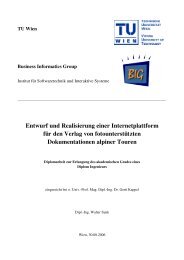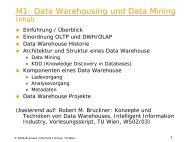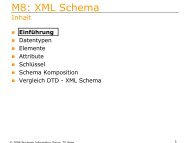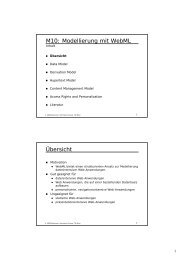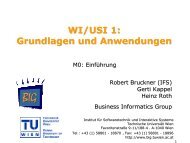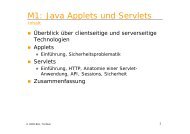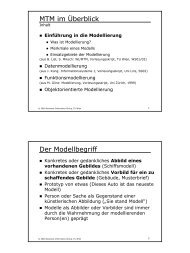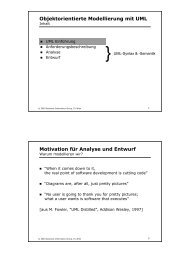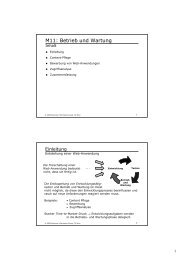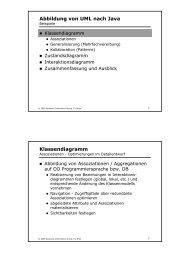Ph.D. Thesis - Business Informatics Group
Ph.D. Thesis - Business Informatics Group
Ph.D. Thesis - Business Informatics Group
You also want an ePaper? Increase the reach of your titles
YUMPU automatically turns print PDFs into web optimized ePapers that Google loves.
1.1.4.1 Tool Adapter<br />
Chapter 1 Introduction<br />
The prerequisite for using the ModelCVS infrastructure is that the models are conform to the<br />
Eclipse Modeling Framework 6 (EMF) XMI and that an Ecore-based metamodel is available.<br />
We decided to use EMF as model repository infrastructure and Ecore as meta-modeling<br />
language, because EMF is currently the most standard conform implementation of the latest<br />
MOF version, thus the terms Ecore and MOF are often used as synonyms in this thesis. If<br />
the models are expressed in other formats, tool adapters are needed to connect ModelCVS<br />
with proprietary tools. Simple tool adapters are used to resolve incompatible XMI files, a<br />
issue which can often be solved with the construction of tool adapters based on XSLT, for<br />
instance, that finally render XMI files interchangeably. In this thesis, the focus lies not on<br />
incompatible XMI files, instead it is focused on problems coming from meta-metamodel<br />
heterogeneity.<br />
When integrating two modeling tools, it is often the case that modeling languages are not<br />
defined with the same meta-language. Although, standardized meta-languages have been<br />
proposed in the model engineering world by the OMG, it is currently not the case that all<br />
modeling languages are defined with the same meta-language. A collection of currently<br />
used meta-languages for language engineering are shown in Figure 1.3.<br />
MOF 1.4<br />
OMG IBM Microsoft<br />
MOF 2.0<br />
UML UML Profile<br />
Ecore<br />
DomainModels<br />
XML Schema DTD EBNF OWL<br />
Markup-Languages<br />
Model Engineering<br />
PLs<br />
RDFS<br />
Ontologies<br />
Figure 1.3: Meta-Languages Used for Language Engineering<br />
For example, even the OMG has proposed two distinct approaches for developing modeling<br />
languages: first, the development from scratch by building a completely new metamodel,<br />
and second, the extension of standard UML by exploiting the profile mechanism<br />
[OMG05e]. For the first approach, dedicated meta-languages are necessary. The OMG has<br />
published the standardized meta-language MOF, however, various versions of MOF are<br />
available, each endowed with its own model serialization technique, i.e., XMI specifica-<br />
© 2007 BIG Vienna University of Technology, TK & IFS University Linz<br />
9<br />
tion. Even within the OMG, an additional meta-language is proposed by the UML-related<br />
group called the UML Infrastructure [OMG03b], which represents the core of UML and is<br />
6 www.eclipse.org/emf<br />
8



